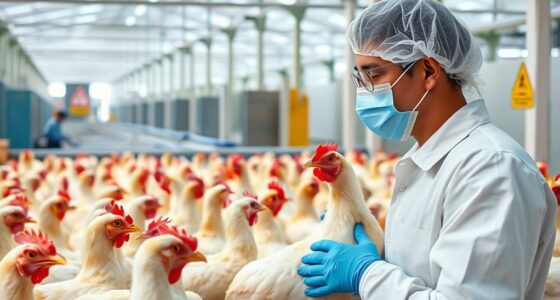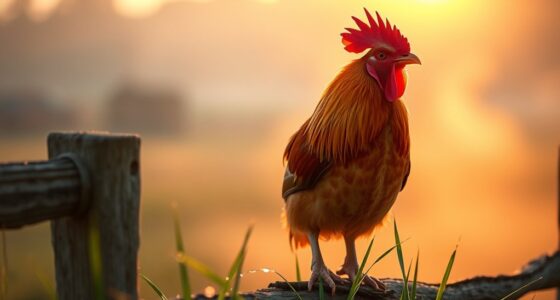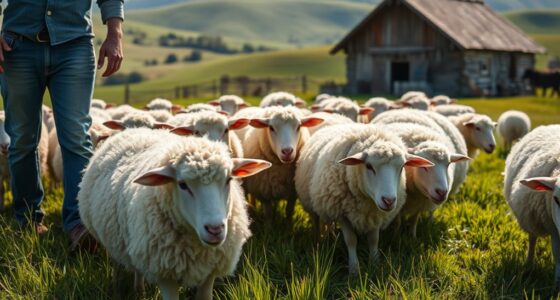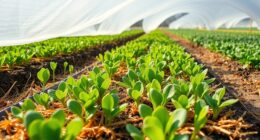Implementing rotational grazing helps safeguard your pasture during drought by preventing overgrazing and allowing plants to recover. By managing grazing schedules and livestock density, you promote healthy, resilient plants and improve soil structure. Monitoring pasture conditions and adjusting your plan guarantee your land remains productive. Incorporating these strategies boosts long-term pasture sustainability and herd health. Keep exploring how effective management can turn drought challenges into opportunities for healthier pastures.
Key Takeaways
- Implement flexible rotational schedules to prevent overgrazing and allow pasture recovery during drought conditions.
- Adjust grazing durations and livestock density based on real-time pasture and soil moisture assessments.
- Divide pastures into manageable sections, rotating livestock to reduce pressure on any single area.
- Monitor forage availability and livestock health closely to prevent stress and overuse of forage resources.
- Develop emergency feed plans and secure alternative feed sources to supplement pasture grazing during drought periods.
Understanding the Benefits of Rotational Grazing During Drought

During drought conditions, rotational grazing becomes an essential strategy to maintain pasture health and livestock productivity. By moving animals between small paddocks, you prevent overgrazing, allowing plants to recover and grow stronger. This approach helps conserve soil moisture and reduces erosion, key concerns during dry periods. It also promotes even grazing, ensuring no single area bears the brunt of feeding, which sustains pasture resilience. Additionally, rotational grazing reduces parasite buildup and improves manure distribution, enriching soil nutrients. It is also beneficial to incorporate effective fraud prevention tools in your management systems to safeguard operational data and transactions. Overall, this system maximizes forage utilization and minimizes pasture degradation during drought, helping you keep your herd healthy and productive despite challenging conditions. Implementing rotational grazing strategically protects your pasture’s future, making drought periods more manageable and less damaging.
Planning Your Grazing System for Drought Resilience

To build a drought-resilient grazing system, you need to prioritize flexible rotational schedules that adapt to changing conditions. Managing livestock density carefully helps prevent overgrazing and preserves forage, even during dry periods. Additionally, having emergency feed plans in place guarantees your operation stays stocked and productive when natural forage falls short. Incorporating grazing management techniques can further enhance the system’s ability to withstand drought conditions.
Rotational Schedule Flexibility
Flexible scheduling is essential for building drought resilience into your rotational grazing system. Drought conditions can change rapidly, so sticking rigidly to a set schedule can leave your pasture vulnerable. By adjusting grazing rotations based on pasture health and forage availability, you give your land time to recover and avoid overgrazing. Monitor your pasture closely, noting growth rates and soil moisture, and be ready to delay or accelerate grazing periods as needed. This adaptability helps maintain healthy forage, reduces soil erosion, and preserves root systems. Incorporating wall organization systems can also help you better visualize and plan grazing areas, promoting more efficient land use. Flexibility also allows you to respond to unexpected drought stress, ensuring your pasture remains productive even under challenging conditions. Ultimately, a responsive schedule keeps your pasture resilient and supports sustainable grazing throughout drought periods.
Livestock Density Management
Managing livestock density is key to maintaining a resilient grazing system during drought conditions. You need to carefully monitor how many animals graze each pasture to prevent overgrazing and soil degradation. By adjusting herd size or grazing duration, you guarantee that pastures have enough time to recover and remain healthy. Avoid overcrowding, which can quickly deplete forage and reduce plant vigor. Instead, use flexible stocking rates that respond to pasture conditions, reducing animal numbers when forage is scarce. This approach helps maintain ideal forage utilization and minimizes soil erosion. Regular assessments of pasture growth and soil health allow you to make timely adjustments, ensuring your grazing system remains sustainable through drought periods. Proper livestock density management is essential for long-term pasture productivity and drought resilience.
Emergency Feed Planning
Are you prepared to provide adequate feed during a drought? Developing an emergency feed plan ensures you won’t be caught off guard. Start by evaluating your current forage supplies and estimating how long they’ll last under drought conditions. Identify alternative feed sources, such as hay, silage, or purchased feed, and secure them early. Consider stocking up when prices are lower and store feed properly to prevent spoilage. Develop a feeding schedule that minimizes waste and maximizes intake. Keep records of feed inventories and consumption rates to adjust plans as needed. Having a clear, actionable plan in place helps you respond quickly, maintain herd health, and reduce stress during difficult times. Proper emergency planning is key to drought resilience. Cookies can also be used to store important preferences and data that help improve your experience and planning efficiency.
Selecting and Managing Pasture Sections Effectively

Choosing the right pasture sections is crucial for successful rotational grazing, as it directly impacts plant health and livestock productivity. You should divide your pasture into manageable sections based on size, forage quality, and soil conditions. Guarantee each section has adequate forage to meet livestock needs without overgrazing. Rotate livestock before plants become stressed, typically when forage reaches 3-4 inches. Managing sections involves controlling grazing duration and rest periods, giving plants time to recover. Avoid grazing sections too frequently, which can lead to soil compaction and reduced regrowth. Keep water sources accessible and mark boundaries clearly. Regularly assess plant vigor and adjust grazing schedules accordingly. Proper selection and management of pasture sections create a sustainable system that conserves forage, promotes healthy growth, and minimizes drought stress. Incorporating proper pasture management techniques ensures long-term productivity and resilience of your grazing system.
Monitoring Pasture and Livestock Health in Drought Conditions

During drought conditions, closely monitoring both pasture and livestock health becomes essential to prevent overgrazing and make sure animals remain well-nourished. Regularly inspect pasture plants for signs of stress, such as wilting, discoloration, or reduced growth. Keep track of pasture height and forage availability to avoid overgrazing in specific areas. For your livestock, observe behavior closely—look for signs of malnutrition like dull coats, decreased activity, or weight loss. Check water sources frequently to ensure proper hydration. Use body condition scoring to assess animals’ health objectively. Monitoring helps you identify issues early, allowing timely adjustments to grazing rotations or supplemental feeding. Understanding nutrient-rich ingredients in forage can help improve animal health during periods of limited pasture availability. Staying vigilant ensures your pasture recovers efficiently and your livestock stays healthy through challenging drought conditions.
Adaptive Strategies for Drought-Related Challenges

When drought hits, adjusting your rotational grazing plan can help safeguard your pasture and livestock. By increasing your grazing intervals and carefully monitoring pasture health, you can reduce stress on the land. Lowering stocking rates ensures your animals get enough forage without overburdening the pasture during tough conditions. Implementing risk assessment practices can further help identify vulnerabilities in your grazing system and develop contingency plans.
Rotational Grazing Benefits
Rotational grazing offers significant benefits when it comes to managing drought-related challenges. By rotating livestock between paddocks, you give pastures time to recover and reduce overgrazing, ensuring plant roots stay healthy and resilient. This practice helps maintain soil structure, improving water infiltration and retention during dry periods. It also promotes even grazing, which prevents certain areas from becoming overburdened and losing productivity. With better pasture health, you minimize feed shortages and reduce reliance on supplemental feed, saving costs. Additionally, rotational grazing encourages diverse plant growth, increasing drought tolerance across your pasture. Incorporating natural materials like wood and stone in farmstead structures can further enhance the sustainability of your grazing system. Overall, this approach enhances pasture resilience, preserves soil quality, and creates a sustainable grazing system that withstands drought conditions, helping you maintain productivity and livestock health even during extended dry spells.
Adjusting Stocking Rates
How can you guarantee your pasture remains productive during drought? The key is adjusting your stocking rates. Reduce the number of animals grazing at any given time to prevent overgrazing and soil degradation. This means carefully monitoring pasture growth and limiting livestock numbers when forage becomes scarce. By doing so, you allow plants to recover and maintain their resilience. Consider temporarily lowering your herd size or rotating animals more frequently to match pasture availability. Keep track of forage availability and animal intake to avoid stress and nutritional deficiencies. Properly adjusting stocking rates helps sustain pasture health, reduces soil erosion, and ensures that forage can rebound once drought conditions improve. Regular assessment and space and organization can further enhance your grazing management, keeping your pasture productive and grazing sustainable during challenging times.
Monitoring Pasture Health
Monitoring your pasture health is essential during drought to make informed management decisions. Regularly observe plant color, noting yellowing or browning, which indicates stress. Check soil moisture levels using a probe or feel the soil to assess dryness. Look for signs of overgrazing, such as bare patches or compacted soil, which hinder recovery. Keep an eye on plant height and density to determine if grazing pressure is too high. Track weed growth or invasive species, as they can signal poor pasture health. Take photos and keep records to monitor changes over time. By staying vigilant, you can adjust grazing timing, rest periods, or supplemental feeding to protect your pasture, ensuring it remains resilient during drought conditions. Incorporating adaptive strategies can further enhance pasture resilience and promote recovery during challenging weather.
Long-Term Benefits of Rotational Grazing for Sustainable Land Use

Implementing rotational grazing offers significant long-term benefits that contribute to sustainable land use. By rotating livestock, you prevent overgrazing, allowing pasture plants to recover and thrive. This practice promotes healthier soil with increased organic matter, which enhances water retention and reduces erosion. It also encourages biodiversity, supporting a variety of native plants and insects that improve ecosystem resilience. Additionally, rotational grazing can increase pasture productivity over time, leading to higher forage yields and better livestock health.
Rotational grazing boosts soil health, biodiversity, and pasture productivity for sustainable land management.
- Rested pastures recover faster, maintaining plant diversity
- Soil quality improves through organic matter buildup
- Water infiltration and retention increase, reducing drought impact
- Biodiversity flourishes, stabilizing ecosystems and reducing pest issues
Frequently Asked Questions
How Does Rotational Grazing Influence Soil Moisture Retention During Drought?
Rotational grazing helps you retain soil moisture during drought by preventing overgrazing and allowing plants to recover. When you move livestock regularly, grasses grow deeper roots and develop stronger structures, which improves their ability to hold water. This process reduces soil compaction and erosion, ensuring moisture stays in the ground longer. As a result, your pasture remains healthier, more resilient, and better equipped to withstand dry conditions.
What Are Common Mistakes to Avoid When Implementing Rotational Grazing in Drought Conditions?
You might think more grazing equals better pasture, but in drought, overstocking is your enemy. Avoid neglecting rest periods for your pasture; it starves your soil of recovery. Don’t ignore soil moisture levels or water availability—pushing animals too hard only worsens drought stress. Keep a close eye on pasture health, rotate wisely, and don’t get complacent. Smart management now prevents future pasture loss, even when water’s scarce.
How Can Technology Assist in Managing Pasture Rotation Effectively During Drought?
Technology can help you manage pasture rotation effectively during drought by providing real-time data on soil moisture, forage growth, and animal movement. Use GPS tracking and grazing management apps to plan rotations precisely, reducing overgrazing and ensuring ideal pasture recovery. Automated weather stations can alert you to drought stress, helping you make timely decisions. Embracing these tools allows you to adapt quickly, conserve resources, and protect your pasture during tough conditions.
What Are the Economic Implications of Switching to Rotational Grazing During Drought?
Switching to rotational grazing during drought acts like a lifeline, saving your pasture’s health and your wallet. While it may require upfront investments in fencing and water systems, it pays off by boosting pasture productivity and reducing feed costs over time. You’ll see fewer expenses, healthier land, and better resilience against drought’s harsh grip, ultimately strengthening your farm’s economic stability and ensuring your livestock thrive despite tough conditions.
How Does Rotational Grazing Impact Biodiversity in Drought-Affected Pastures?
Rotational grazing boosts biodiversity in drought-affected pastures by preventing overgrazing and giving plants time to recover. You enable diverse plant species to thrive, which attracts various insects, birds, and other wildlife. This practice creates a resilient ecosystem that withstands drought stress better. As you move livestock regularly, you promote healthier soil and plant growth, ultimately supporting a richer, more balanced environment even during challenging drought conditions.
Conclusion
By adopting rotational grazing now, you set your pasture on a path to resilience, much like ancient farmers who thrived through adaptability. As you monitor and adjust your system, you’ll protect your land from drought’s harsh grasp, ensuring sustainability for generations to come. Remember, this isn’t just about avoiding a dry season; it’s about cultivating a legacy of smart land stewardship that endures beyond any plague or pestilence. Stay vigilant, and your pasture will flourish, come rain or shine.










